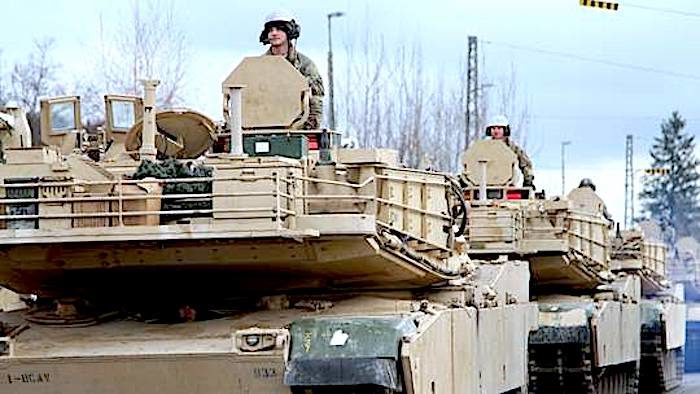
The main objective of the exercise — NATO's largest in over 25 years — is to practice deploying US troops to Poland and the Baltic states. As part of the drill, up to 20,000 US troops will be deployed to Europe by air and sea, as well as 13,000 vehicles and equipment. 37,000 soldiers from 18 countries will take part in Defender-Europe 2020 altogether. These exercises will last about five months, and will take place mostly in Germany, Poland, and the Baltic states, with the bulk of the activities scheduled for April and May.
On Monday, the first units from Britain arrived in Belgium's Antwerp.
NATO denies the notion that Russia is the portrayed enemy in Defender Europe 2020. According to General Andrew Rohling, Deputy Commander of the US Armed Forces in Europe, "the military maneuver is not related to any particular country. It aims to respond quickly to any crisis."
This is echoed by the alliance's chief Jens Stoltenberg, who insisted this week that "Defender Europe 2020 is not aimed at any particular country."
However, judging by its name, such a massive deployment of troops can only serve for exercising a strategic defense in the European theater of operations. The objective of such an operation would be to counter an invasion and strike back with full force, making sure that the enemy would stop the hostilities and agree to a truce that would benefit NATO.
Needless to say, NATO has only one potential enemy in the European strategic region that is somewhat equal to the alliance in terms of military capabilities. No matter what NATO's political and military leaders say, it's Russia.
Naturally, we don't know the details of the planned exercise, but we do have reasons to believe that if Supreme Headquarters Allied Powers Europe (SHAPE) decided to practice a strategic defensive operation in the region, they will have to prioritize certain zones, regions and borders where the main forces will be deployed in anticipation of an attack from the East.
What will this look like in reality? Obviously, Moscow will not get any coherent answer regarding the specifics of the upcoming exercises, but it would be interesting to hear what SHAPE might have to say. Is it "to prevent Russian forces from reaching the Baltic Sea near Liepaja and Klaipeda thus isolating NATO's units in Latvia and Estonia?" Or maybe "to prevent Russians from crossing the middle reaches of the Vistula river in Poland on a wide front?"
NATO officials might claim in public that one of the goals of Defender Europe 2020 is to practice transferring American troops to Poland and the Baltic states. However, operational officers at operational-strategic and strategic headquarters use a different language. They call it "strategic deployment of US and NATO forces to the European theater of operations." Now, this is the part of the strategic deployment of armed forces that is usually followed by real war in a matter of hours and minutes.
Claudia Major from German Institute for International and Security Affairs (SWP) says that Defender Europe 2020 doesn't play out a specific scenario of an offensive, but rather focuses on deploying the troops.
"The main objective is to figure out whether it's possible to move troops across Europe in a matter of days in case of a crisis," the expert told Deutsche Welle.
So what is this crisis that requires deploying US and NATO troops from one theater of operations to another?
While transferring troops to different parts of Europe might sound pretty harmless, from a military perspective, it actually means setting up a battle force for an offensive, or creating a defensive line.
Even during exercises, troops do not move around aimlessly, but are rather transferred with specific objectives in mind, like, for example, creating a force in a strategic area. Naturally, any defensive exercise will include a counter strike aimed at crushing the invading forces — apparently Russia is being seen as the enemy in this case. Most certainly, this part of the exercise will result in some 'miraculous victory' over the hordes from the East, and it will happen in a symbolic location.
To sum it all up — no one should be fooled by terms like "transportation," "logistics" and "testing roads and bridges." Defender Europe 2020 is an exercise of strategic defense and its objective is to counter a 'Russian invasion.' Since there is no indication that Moscow would ever seek to invade Europe, it's clear that these exercises are anti-Russian in nature, and are yet another planned provocation against Russia.
About the Author:
Mikhail Khodarenok, military commentator for RT.com. He is a retired colonel. He graduated from the Minsk Higher Engineering School of Anti-Aircraft Missile Defense (1976) and the Command Academy of the Air Defense Forces (1986). Commanding officer of the S-75 AA missile battalion (1980-1983). Deputy commanding officer of a SAM regiment (1986-1988). Senior officer at the High Command of the Air Defense Forces (1988-1992). Officer at the main operational directorate of the General Staff of the Armed Forces (1992-2000). Graduated from the Military Academy of the General Staff of the Armed Forces of the Russian Federation (1998). Worked as an analyst at Nezavisimaya Gazeta (2000-2003) and editor-in-chief of Voyenno-Promyshlennyi Kuriyer (2010-2015).



Comment: Without the Russian sticker face, NATO has little to validate its reason to be. Given that most military aggression is set in motion by Western nations, NATO looks in the mirror but sees the enemy.